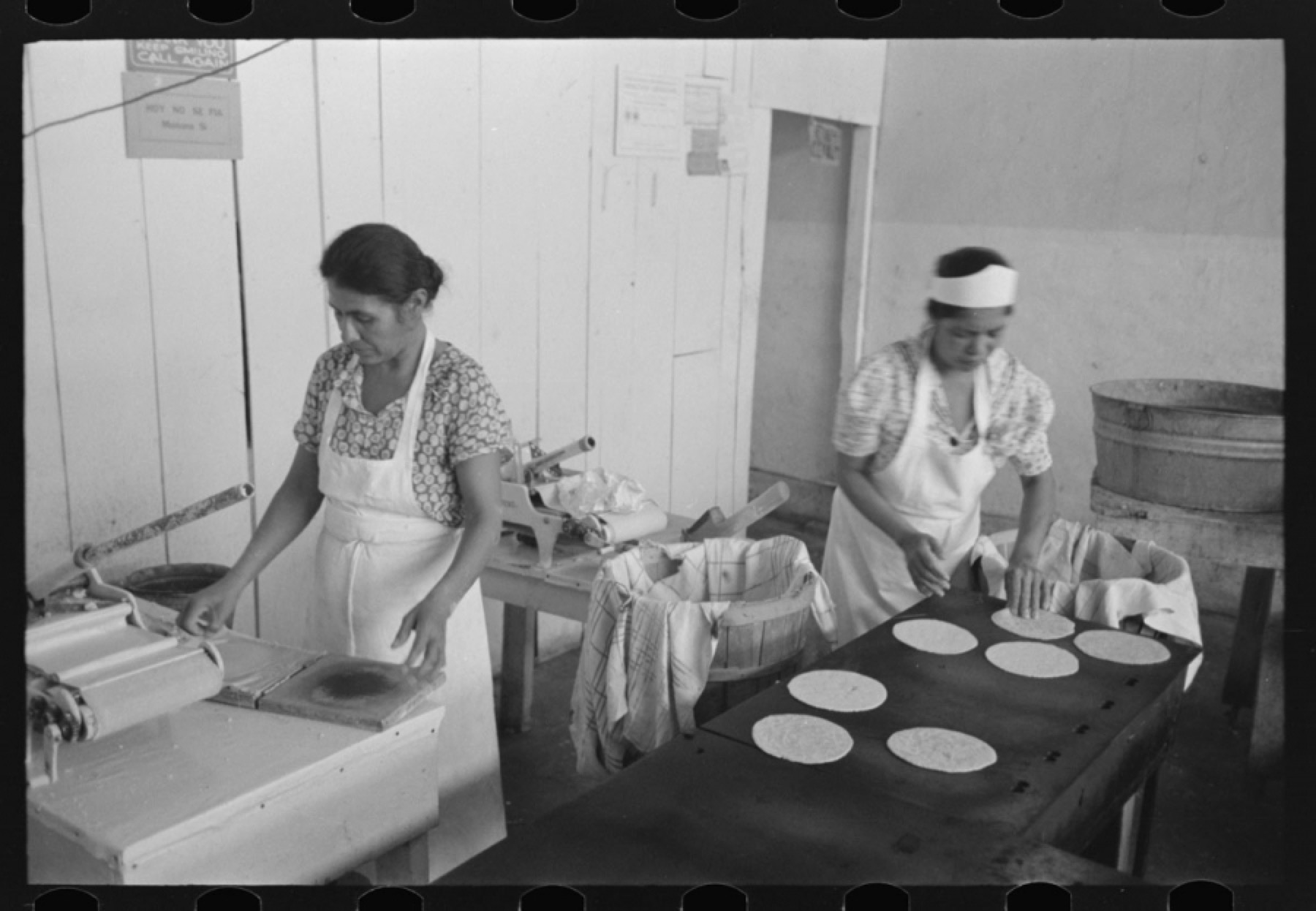
Making corn tortillas in bake shop, San Antonio, Texas. Photograph by Russell Lee, 1939. Courtesy of the Library of Congress
THE MEXICAN REVOLUTION AND THE REVOLUTION OF LOVE
By Bárbara Renaud González
The Alma in the Alamo: Stories from San Antonio’s 300th year
What many people don’t understand is that immigrants are like everyone else, but they are different, too. Some are well-off, even rich, like the first Cubans arriving in Florida during the Cuban Revolution. Some are indigenous, rich in indigenous culture, but illiterate in English and Spanish. The elite arrive in this country with their dictatorship histories alongside those fleeing and protesting the revolutions responding to the dictatorships. Most know nothing of democracy; they just want another chance.
The Mexican Revolution of 1910 brought many now-prominent families to San Antonio. Now, as the city celebrates its Tricentennial year, they have names like Cisneros, Romo, Castro, Briseño, and Velasquez. Over one million people died in the Mexican Revolution, about ten percent of its population, but despite the wars, and the conflicted pasts we carry beyond them, sometimes young people fall in love. Think of it as the essential American dream, so inevitable it is magical: an American Dream made of love letters.
Josefina and Jimmie D. Briseño met in San Antonio because of the Revolution. Josefina’s mother brought the family here because she was a wealthy landowner and saw the possible repercussions to her family. Jimmie Briseño was from South Texas, a Tejano from a working-class background. Josefina’s father, from Mexico’s upper-crust, flatly resisted the impoverished Jimmie Briseño and kept the couple apart for seven years. When he separated them, love letters became their hope. They were eventually married and raised five children, who grew up on the Westside, the city’s oldest and poorest barrio. All of their children graduated from college—among them is an artist, a city manager, a physician, an entrepreneur, and a teacher.
Rolando Briseño, their youngest son, is an acclaimed visual artist who’s lived in New York City and Italy, but now lives again in his hometown. His older brother, Alex, a widely-respected former city manager, is known for his civic leadership and teaching.
Rolando graduated from Columbia University. He is known for his “table” paintings, abstract interpretations of the dramatic integration of his cultural history—Mexican and American. He remembers corn tortillas, mole (the essential Mexican chocolate-based gravy), and—thanks to his mother’s family—caviar and the diverse and exceptional Mexican table of his youth. It was a table, he says, that reminds him of Italy and France with its formal settings, silverware, and multi-courses of soup, rice, a main dish, and dessert. Starched linens. Always.
Rolando’s best-known sculpture, “The Learning Tree,” is at Trinity University in Northrup Hall. The hand-forged bronze piece stands thirty-five feet tall. Within his community, however, he is best known for his title as a “Cultural Adjuster,” organizer of “Flippin’ San Alamo Fiesta,” a cultural/political event that takes place in front of the Alamo every June 13, the day San Antonio was founded by the Spaniards.
 Rolando Briseño pictured with Flippin’ San Antonio positioned upright. Photos by Ruben C. Cordova from the exhibition The Other Side of the Alamo: Art Against the Myth
Rolando Briseño pictured with Flippin’ San Antonio positioned upright. Photos by Ruben C. Cordova from the exhibition The Other Side of the Alamo: Art Against the Myth
San Antonio is the patron saint of lost causes, and Rolando created a statue of him in faux-marble white with the Alamo perched like a hat, except that the saint is upside down, so the Alamo is at his feet. When you want something, Rolando says, you flip the statue upside down. At his first festival in 2010, which you can find on YouTube, the giant lightweight statue seems to be on a rotisserie-like apparatus that is turned by an actor—shirtless, wearing a long, thick chain around his neck—made to represent the region’s legacy of slave labor. There is also an Alamo piñata in red, white, and blue. “The complete story needs to be told,” says Rolando, and in his paintings, his sculpture, and his “Flippin’ San Alamo,” he is reconciling the worlds inside him—the class divisions of Mexico that caused the Mexican Revolution, the Catholic Church’s role in the acquisition of Mexican land and wealth, and the Alamo’s glorification of a war of independence based on slavery and colonialism.
The first time Rolando invited me to see his festival I was too tired, and it was too hot outside. Now I wish I’d been there. Sandra Cisneros used to tell me that it’s important for a writer to have a wide-scope vision of the world—and artists like Rolando have the widest vision of all.
Rolando once constructed an edible Alamo made of masa. This is the best food you will ever taste—organic, blue or red, from Mexico and Guatemala. Black beans, too. The seven moles, the various colors of our gravy, throughout Mexico. Aphrodisia. Tragically, too many of us eat the flour tortillas that the Spaniards invented here, and they’ve become a primary culprit in our increasing rate of diabetes.
I wish that democracy tasted as good as our corn tortillas. Of course, the worlds in our lives circle, collide, and sometimes fall into each other, but they don’t have to kill each other. I guess if Chopin could compose a mazurka from the invasions of Poland and his beloved polkas, the music Rolando heard all his life, we can create something equally beautiful. Even if we can’t hear it right now.
“The Alma in the Alamo: Stories from San Antonio’s 300th year” is a part of our weekly story series, The By and By.
Enjoy this story? Subscribe to the Oxford American.

